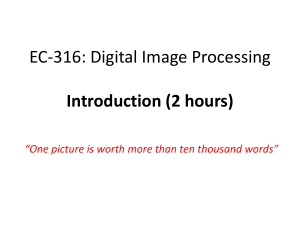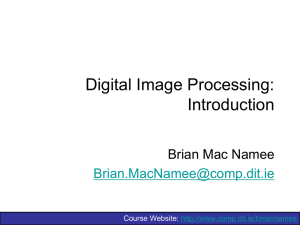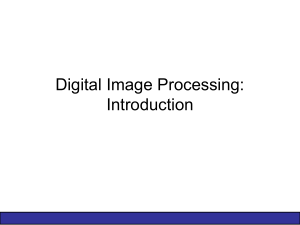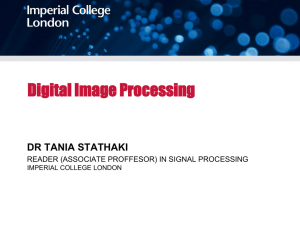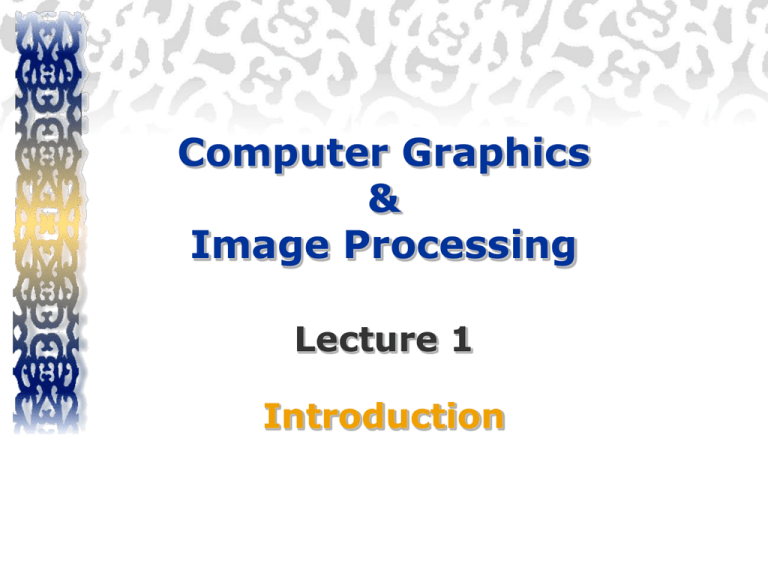
Computer Graphics
&
Image Processing
Lecture 1
Introduction
ROBIN WALIA
Lecturer
ECE DEPARTMENT
MMEC, MULLANA-AMBALA
Email:: robinwalia1@gmail.com
Office Room #:: 220
Text Book (s)
Gonzalez, R. C. and Woods, R. E., Digital Image
Processing, Second Edition, Pearson-Prentice Hal
l,
Inc., 2002. ISBN 81-7758-168-6.
Gonzalez, R. C., Woods, R. E., and Eddins, S. L.,
Digital Image Processing Using MATLAB®, Pearson
-Prentice Hall, Inc., 2004, ISBN 81-7758-898-2.
Computer Graphics
Graphics are visual presentations on some surface, such
as a wall, computer screen, paper, or stone to brand, or
entertain. Examples are photographs, drawings, graphs,
diagrams, maps, engineering drawings, or other images
Computer graphics are graphics created using
computers and, more generally, the representation and
manipulation of pictorial data by a computer.
Developments in computer graphics have had a profound
impact on many types of media and have revolutionized
the animation and video game industry.
Computer Graphics
The term Computer Graphics has several meanings:
• the representation and manipulation of pictorial data by a
computer
• the various technologies used to create and manipulate such
pictorial data, and
• the images so produced
What is an Image?
Image is a source of information according to
information theory
An image may be defined as a two dimensional
function f(x,y) where x and y are spatial
coordinates and amplitude of f at any pair of
coordinates (x,y) is called the intensity or Gray
level of the image at that point.
Digital Image
When x,y and the amplitude values of f are all finite,
discrete quantities, we call the image a Digital Image.
A digital Image is composed of a finite number of
elements each of which has a particular location and value
These elements are referred to as Picture Elements, Image
Elements, Pels or Pixels.
Pixel
In digital imaging, a pixel is the smallest piece of
information in an image.
Pixels are normally arranged in a regular 2-dimensional
grid, and are often represented using dots or squares
The intensity of each pixel is variable; in color systems,
each pixel has typically three or four components such as
red, green, and blue, or cyan, magenta, yellow, and black
Why do we Process Images?
Facilitate picture storage and transmission
Enhance and restore images
Extract information from images
Prepare for display or Printing
EM Spectrum
Key Stages in Digital Image Processing
Image
Restoration
Morphological
Processing
Image
Enhancement
Segmentation
Image
Acquisition
Representation
&
Description
Problem Domain
Object
Recognition
Color Image
Processing
Image
Compression
Images taken from Gonzalez & Woods, Digital Image Processing (2002)
Key Stages in Digital Image Processing:
Image Acquisition
Image
Restoration
Morphological
Processing
Image
Enhancement
Segmentation
Image
Acquisition
Representation
&
Description
Problem Domain
Object
Recognition
Color Image
Processing
Image
Compression
Images taken from Gonzalez & Woods, Digital Image Processing (2002)
Key Stages in Digital Image Processing:
Image Enhancement
Image
Restoration
Morphological
Processing
Image
Enhancement
Segmentation
Image
Acquisition
Representation
&
Description
Problem Domain
Object
Recognition
Color Image
Processing
Image
Compression
alez & Woods, Digital Image Processing (2002)
Key Stages in Digital Image Processing:
Image Restoration
Image
Restoration
Morphological
Processing
Image
Enhancement
Segmentation
Image
Acquisition
Representation
&
Description
Problem Domain
Object
Recognition
Color Image
Processing
Image
Compression
Images taken from Gonzalez & Woods, Digital Image Processing (2002)
Key Stages in Digital Image Processing:
Morphological Processing
Image
Restoration
Morphological
Processing
Image
Enhancement
Segmentation
Image
Acquisition
Object
Recognition
Problem Domain
Representation
&
Description
Color Image
Processing
Image
Compression
Images taken from Gonzalez & Woods, Digital Image Processing (2002)
Key Stages in Digital Image Processing:
Segmentation
Image
Restoration
Morphological
Processing
Image
Enhancement
Segmentation
Image
Acquisition
Representation
&
Description
Problem Domain
Object
Recognition
Color Image
Processing
Image
Compression
Images taken from Gonzalez & Woods, Digital Image Processing (2002)
Key Stages in Digital Image Processing:
Representation & Description
Image
Restoration
Morphological
Processing
Image
Enhancement
Segmentation
Image
Acquisition
Representation
& Description
Problem Domain
Object
Recognition
Color Image
Processing
Image
Compression
Images taken from Gonzalez & Woods, Digital Image Processing (2002)
Key Stages in Digital Image Processing:
Object Recognition
Image
Restoration
Morphological
Processing
Image
Enhancemen
t
Segmentation
Image
Acquisition
Representation
&
Description
Problem Domain
Object
Recognition
Color Image
Processing
Image
Compression
Key Stages in Digital Image Processing:
Image Compression
Image
Restoration
Morphological
Processing
Image
Enhancement
Segmentation
Image
Acquisition
Representation
&
Description
Problem Domain
Object
Recognition
Color Image
Processing
Image
Compression
alez & Woods, Digital Image Processing (2002)
Key Stages in Digital Image Processing:
Colour Image Processing
Image
Restoration
Morphological
Processing
Image
Enhancement
Segmentation
Image
Acquisition
Representation
&
Description
Problem Domain
Object
Recognition
Color Image
Processing
Image
Compression
Applications of Image Processing
1. Image Restoration
Image Colorization
Image Enhancement
Face Detection
Face Tracking
Face Morphing
Finger Print Recognition
Personal Identification Using
Iris Recognition
Image Processing Components
Image Sensing device
Storage Media
Processing Systems
Displays
Communication Media
Hardcopy devices (e.g Printer)
Camera
Lens (CMount, CSMount, Motorized)
Optical Filter (Selectivity in EM waves)
Imaging Sensor (CCD Sensor)
Flash (Used for lighting/Illumination)
Front Illumination
Back Illumination
Digitizer
Processing systems
PC based
General purpose PCs
Servers
Industrial PCs
Embedded system based
DSP processor based
FPGA based
System on chip (SoC)
Any question

